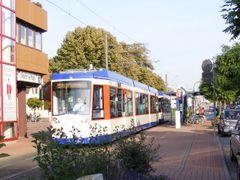ES:Tranvías

|
| Descripción |
| A form of public transport |
| Etiquetas |
Si comprendes el artículo original en inglés, por favor, ayuda a completar esta traducción al español. Lee las instrucciones sobre cómo traducir este wiki.
Parece que nadie está trabajando en la traducción en este momento. Anímate y colabora en la tarea de traducción.
Differences to other railways
Trams are unique among rail-based public transport systems in that, for at least some of their route, they travel along the road, rather than on a separate rail corridor. Where the tracks are embedded within the road, the trams may share the space with other road traffic, such as private motor vehicles, or perhaps buses and taxis only. Sometimes, for instance on wide roads, trams may have their own tracks on which only they can travel, separated from the main road traffic by a small island (in a similar way to some cycle paths). In other circumstances, road traffic and trams may share the same space, but different restrictions (turns, one-way, etc) may apply.
Tram tracks
Tram tracks are tagged with railway=tram.
Most often there are two tracks, one track in each direction, running parallel to each other. It is recommended to draw each tracks separately. In the past the tracks where often mapped as as a single line representing both tracks with tracks=2.
Tram tracks are sometimes physically embedded within the highway, and sometimes completely separate.
Embedded tracks
Tram tracks integrated within an highway, where other traffic is allowed to share the same space.
Latest trend in mapping embedded tracks is to separate geometry of tram tracks and highways entirely. Highway is mapped by a way highway=* with its tags and each single track is mapped as a railway=tram according to its real position. This has many positives (precision, intuitivity, editing ease, less tags on all the ways etc.) but also few negatives, most notably losing information that track is embedded into highway (possibly important for routing purposes). See this section of the Karlsruhe, Germany map for examples of all these situations.
In the past some mappers have drawn a new way for the tram tracks but reuse the nodes as the street where they run completely parallel. This has the drawback that ways are harder to select in visual editors. To draw the railway on top of the street but using its own nodes suffers from the same issue.
A different method, which is used is to draw a single way with both the highway=* and railway=* set at the same time contradicts the One_feature,_one_OSM_element principle.
Separate tracks
Where tram tracks separate the road into two carriageways (one for each direction), the road is usually mapped as two ways with oneway=yes, and the tram tracks are mapped as ways in the middle.
Where tram tracks run to the left or right of the road, each track is usually drawn as a separate way on the appropriate side.
Tram stops
A tram stop is a place where a passenger can embark/disembark a tram. It generally comprises a sign, maybe with a small shelter, timetable and facilities for unattended ticket sales (vending machines). There are no operating staff present.
Stops are marked by a single node with the tags public_transport=stop_position and tram=yes. Historically they were mapped with just railway=tram_stop, but the tag usage is declining in favour of the former (taginfo).
Platforms, where passengers await and board the coaches can be tagged as a node or area aside the stop with the tags public_transport=platform, and/or the declining railway=platform.
Tram service routes
see Public Transport
Tram systems by country
Finland
Poland
Slovakia
Switzerland
United Kingdom
| ||||||||||||||||||||||||||||||||||||||||||||||